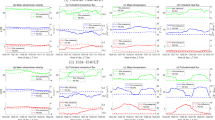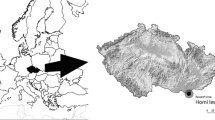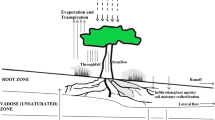Abstract
Previous studies that measured the natural frequencies and damping ratios of conifer trees were reviewed and results synthesized. Analysis of natural frequency measurements from 602 trees, belonging to eight different species, showed that natural frequency was strongly and linearly related to the ratio of diameter at breast height to total tree height squared (i.e., DBH/H 2). After accounting for their size, pines (Pinus spp.) were found to have a significantly lower natural frequency than both spruce (Picea spp.) and Douglas-fir (Pseudotsuga spp.). Natural sway frequencies of de-branched trees were significantly higher than those of the same trees with the branches intact, and the difference increased with an increasing ratio of DBH/H 2. Damping mechanisms were discussed and methods for measuring damping ratio were presented. Analysis of available data suggested that internal damping ratios were typically less than 0.05 and were not related to tree diameter. External damping was mainly due to aerodynamic drag on the foliage and contact between the crowns of adjacent trees. Analysis of data from previous wind-tunnel studies indicated that damping due to aerodynamic drag is a nonlinear function of velocity. Damping due to crown contact has been suggested by a previous author to be a function of both the distance to and the size of adjacent trees. Therefore, in uniformly spaced stands it may be possible to model crown contact damping as a function of stand density index (SDI), a common forestry measure which incorporates both of these variables.




Similar content being viewed by others
References
Baker CJ (1995) The development of a theoretical model for the windthrow of plants. J Theor Biol 175:355–375
Baker CJ (1997) Measurement of the natural frequencies of trees. J Exp Bot 48:1125–1132
Blackburn P, Miller KF, Petty JA (1988) An assessment of the static and dynamic factors involved in windthrow. Forestry 61:29–43
Clough RW, Penzien J (1993) Dynamics of structures. McGraw Hill, New York
Everham EM (1995) A comparison of methods for quantifying catastrophic wind damage to forests. In: Coutts MP, Grace J (eds) Wind and trees. Cambridge University Press, Cambridge, pp 340–357
Flesch TK, Wilson JD (1999) Wind and remnant tree sway in forest cutblocks. II. Relating measured tree sway to wind statistics. Agric For Meteorol 93:243–258
Forest Products Laboratory (1999) Wood handbook—wood as an engineering material. Gen Tech Rep FPL-GTR-113, U.S. Department of Agriculture, Forest Service, Forest Products Laboratory, Madison, Wis.
Furnival GM (1961) An index for comparing equations used in constructing volume tables. For Sci 7:337–341
Gardiner BA (1992). Mathematical modelling of the static and dynamic characteristics of plantation trees. In: Franke J, Roeder A (eds) Mathematical modelling of forest ecosystems. Sauerländer, Frankfurt/Main, pp 40–61
Gardiner BA, Stacey GR, Belcher RE, Wood CJ (1997) Field and wind tunnel assessments and the implications of respacing and thinning for tree stability. Forestry 70:233–252
Hassinen A, Lemettinen M, Peltola H, Kellomaki S, Gardiner B (1998) A prism-based system for monitoring the swaying of trees under wind loading. Agric For Meteorol 90:187–194
Hoag DL, Fridley RB, Hutchinson JR (1971) Experimental measurement of internal and external damping properties of tree limbs. Trans ASAE 14:20–28
Holbo HR, Corbett TC, Horton PJ (1980) Aeromechanical behaviour of selected Douglas-fir. Agric Meteorol 21:81–91
Kerzenmacher T, Gardiner BA (1998) A mathematical model to describe the dynamic response of a spruce tree to the wind. Trees 12:385–394
Larsen DR, Hann DW (1987) Height diameter equations for seventeen tree species in southwest Oregon. Research Paper 49. Oregon Forest Research Laboratory, Oregon State University, Corvallis, Ore.
Loo SP (1975) Aerodynamic characteristics of a flexible structure (tree). ME Thesis, University of Canterbury, Christchurch
Mayer H (1987) Wind-induced tree sways. Trees 1:195–206
Mayhead GJ (1973a) Sway periods of forest trees. Scot For 27:19–23
Mayhead GJ (1973b) Some drag coefficients for British forest trees derived from wind tunnel studies. Agric Meteorol 12:123–130
Mayhead GJ, Gardiner JBH, Durrant DW (1975) A report on the physical properties of conifers in relation to plantation stability, Unpublished report of the Forestry Commission Research and Development Branch, Edinburgh
Means JE, Hansen HA, Koerper GJ, Alaback PB, Klopsh MW (1994) Software for computing plant biomass—BIOPAK users guide. Gen Tech Rep PNW-GTR-340. U.S. Department of Agriculture, Forest Service, Pacific Northwest Research Station, Portland, Ore.
Milne R (1991) Dynamics of swaying Picea sitchensis . Tree Physiol 9:383–399
Niklas KJ (1992) Plant biomechanics: an engineering approach to plant form and function. The University of Chicago Press, Chicago
Nowacki GJ, Kramer MG (1998) The effect of wind disturbance on temperate rain forest structure and dynamics of southeast Alaska. Gen Tech Rep PNW-GTR-421. U.S. Department of Agriculture, Forest Service, Pacific Northwest Research Station, Portland, Ore.
O’Sullivan MF, Ritchie RM (1992) An apparatus to apply dynamic loads to forest trees. J Agric Eng Res 51:153–156
Papesch AJG (1984) Wind effects on (Canterbury) forests. Ph.D Thesis, University of Canterbury, Christchurch
Peltola H, Kellomaki S, Hassinen A, Lemittinen M, Aho J (1993) Swaying of trees as caused by wind: analysis of field measurements. Silva Fenn 27: 113-126
Quine CP (1995) Assessing the risk of wind damage to forests: practices and pitfalls. In: Coutts MP, Grace J (eds) Wind and trees. Cambridge University Press, Cambridge, pp 379–403
Quine CP, Gardiner BA (1991) Storm damage to forests: a major abiotic threat with global occurrence. Proceedings of the Tenth World Forestry Conference, Paris, September, 1991, Paris, pp 339–345
Raymer WG (1962) Wind resistance of conifers. Report 1008. National Physical Laboratory, Aerodynamics Division, Teddington
Reineke JL (1933) Perfecting a stand density index for even-aged forests. J Agric Res 46:627–638
Rodgers M, Casey A, McMenamin C, Hendrick E (1995) An experimental investigation of the effects of dynamic loading on coniferous trees planted on wet mineral soils. In: Coutts MP, Grace J (eds) Wind and trees. Cambridge University Press, Cambridge, pp 204–219
Roodbaraky HJ, Baker CJ, Dawson AR, Wright CJ (1994) Experimental observations of the aerodynamic characteristics of urban trees. J Wind Eng Ind Aerodyn 52:171–184
Sugden MJ (1962) Tree sway period—a possible new parameter for crown classification and stand competition. For Chron 38:336–344
Vogel S (1988) Life’s devices: the physical world of animals and plants. Princeton University Press, Princeton, New Jersey
White RG, White MF, Mayhead GJ (1976) Measurement of the motion of trees in two dimensions. Research Report 86, University of Southampton, Institute of Sound and Vibration, Southampton
Wood CJ (1995) Understanding wind forces on trees. In: Coutts MP, Grace J (eds), Wind and trees. Cambridge University Press, Cambridge, pp 133–164
Acknowledgements
This review was made possible through funding from the Department of Forest Resources at Oregon State University and the New Zealand Forest Research Institute Ltd. The authors would also like to thank Mr. Martin Sugden for allowing his data to be used, and Mr. Bruce Nicoll for his assistance in obtaining the data from the British Forestry Commission’s tree pulling program. Drs. Daniel Edge, Barry Gardiner, David Hann, Michael Unsworth, Solomon Yim and two anonymous reviewers provided useful comments on an earlier version of this paper.
Author information
Authors and Affiliations
Corresponding author
Rights and permissions
About this article
Cite this article
Moore, J.R., Maguire, D.A. Natural sway frequencies and damping ratios of trees: concepts, review and synthesis of previous studies. Trees 18, 195–203 (2004). https://doi.org/10.1007/s00468-003-0295-6
Received:
Accepted:
Published:
Issue Date:
DOI: https://doi.org/10.1007/s00468-003-0295-6




